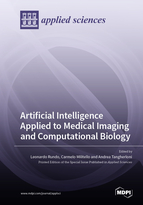Artificial Intelligence Applied to Medical Imaging and Computational Biology
A special issue of Applied Sciences (ISSN 2076-3417). This special issue belongs to the section "Computing and Artificial Intelligence".
Deadline for manuscript submissions: closed (30 April 2022) | Viewed by 36705
Special Issue Editors
Interests: biomedical image analysis; radiogenomics; machine learning; computational Intelligence; high-performance computing
Special Issues, Collections and Topics in MDPI journals
Interests: biomedical image analysis; radiomics; machine learning; digital architectures; biometrics; hardware programmable devices
Special Issues, Collections and Topics in MDPI journals
Interests: computational systems biology; bioinformatics systems; biology; high-performance computing; computational intelligence; machine learning
Special Issues, Collections and Topics in MDPI journals
Special Issue Information
Dear Colleagues,
Medical imaging and computational biology continuously pose new fundamental medical and biological questions that often give rise to novel challenges in Artificial Intelligence (AI). Thus, in these research fields, there is an increasing need for the application of cutting-edge computational approaches that generally involve Machine Learning (ML) or Computational Intelligence (CI) techniques. On the one hand, ML and CI techniques can effectively perform image processing operations (such as segmentation, co-registration, classification, and dimensionality reduction), in the fields of neuroimaging and oncological imaging. Although the manual approach often remains the golden standard in some tasks (e.g., segmentation), ML can be exploited to automate and facilitate the work of researchers and clinicians. On the other hand, ML- and CI-based strategies have been continuously applied to solve problems in Bioinformatics and Computational Systems Biology (e.g., alignments, dimensionality reduction, and parameter estimation). In addition, these fields often present new clustering and classification challenges, as well as combinatorial problems, which can be effectively addressed using novel strategies based on ML and CI techniques. Frequently used approaches include Support Vector Machines (SVMs) for classification problems, graph-based methods, Artificial Neural Networks (ANNs), Evolutionary Computation (EC) and Swarm Intelligence (SI) techniques.
More recently, Deep Learning (DL) approaches were shown to be very successful in computer vision and bioinformatics tasks owing to their ability to automatically extract hierarchical descriptive features from input images or gene expression data. They have also been used in the oncological, neuroimaging, and microscopy imaging domains for the automatic disease diagnosis, tissue segmentation, and even synthetic image generation. The main issue, however, remains the relative sample paucity of the typical datasets that leads to poor generalization of the employed deep ANNs, considering the high number of required parameters. Consequently, parameter-efficient design paradigms specifically tailored to biomedical applications ought to be devised, also by exploiting CI-based techniques (e.g., EC, SI, and neuroevolution).
In this context, these advanced ML techniques can be suitably exploited to combine heterogeneous sources of information, allowing for multiomics data integration. Such kinds of analyses may represent a significant step towards personalized medicine.
This Special Issue will provide a forum to publish original research papers covering state-of-the-art and novel algorithms, methodologies, and applications of AI methods for biomedical data analysis, ranging from classic ML to DL.
Topics of interest include but are not limited to:
- ML and CI techniques for segmentation, co-registration, classification, or dimensionality reduction of medical images.
- Generative adversarial models for medical image super-resolution, denoising, and synthesis.
- Deep learning for neuroimaging and oncological imaging analysis.
- Application of graph theory to MRI and functional MRI (fMRI) data.
- Computational modeling and analysis of neuroimaging.
- Radiomic analyses for disease phenotyping.
- Radiogenomics for intra- and intertumoral heterogeneity evaluation.
- CI methods for optimizing biomedical data analysis tasks.
- Integration of multiomics data.
- ML and CI techniques for combinatorial problems in bioinformatics and computational biology.
- Deep neural networks for classification tasks in single-cell data analysis.
- New clustering approaches for single-cell data analysis.
Dr. Leonardo Rundo
Dr. Carmelo Militello
Dr. Andrea Tangherloni
Guest Editors
Manuscript Submission Information
Manuscripts should be submitted online at www.mdpi.com by registering and logging in to this website. Once you are registered, click here to go to the submission form. Manuscripts can be submitted until the deadline. All submissions that pass pre-check are peer-reviewed. Accepted papers will be published continuously in the journal (as soon as accepted) and will be listed together on the special issue website. Research articles, review articles as well as short communications are invited. For planned papers, a title and short abstract (about 100 words) can be sent to the Editorial Office for announcement on this website.
Submitted manuscripts should not have been published previously, nor be under consideration for publication elsewhere (except conference proceedings papers). All manuscripts are thoroughly refereed through a single-blind peer-review process. A guide for authors and other relevant information for submission of manuscripts is available on the Instructions for Authors page. Applied Sciences is an international peer-reviewed open access semimonthly journal published by MDPI.
Please visit the Instructions for Authors page before submitting a manuscript. The Article Processing Charge (APC) for publication in this open access journal is 2400 CHF (Swiss Francs). Submitted papers should be well formatted and use good English. Authors may use MDPI's English editing service prior to publication or during author revisions.
Keywords
- machine learning
- deep learning
- computational intelligence
- biomedical image analysis
- radiomics
- radiogenomics
- bioinformatics
- computational biology
- multiomics data
- single-cell data analysis








